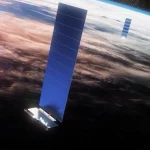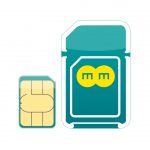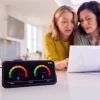VodafoneThree UK Hits 1.65 Million Broadband Users as Mobile Tops 28.76m UPDATE

Broadband and mobile operator Vodafone has published their first combined Q1 FY26 financial results with Three UK. The figures show that the merged entity has 1.654 million fixed broadband customers (up by 44k in Q1 vs 61k in the previous quarter) and a huge combined mobile base of 28.765m – making them the “biggest mobile network operator in the UK“.
In terms of their fixed broadband services, Vodafone reported more growth, with a quarterly addition of 44,000 customers – thanks in part to being widely available across both Openreach’s and CityFibre’s national networks. The provider’s full fibre (FTTP) coverage can now reach a combined total of 20.3 million UK households (up from 19.4m last quarter).
As for their mobile base, the combined operator reported a quarterly fall of -46,000 in Pay Monthly customers (vs an increase of 41,000 in Q4) and there was another fall of -235,000 in Prepaid / PAYG customers (vs -166k in Q4). Finally, quarterly mobile broadband (data) usage across their UK network increased to 722,621 TeraBytes (up from 655,568 TB last quarter).
Advertisement
However, it’s important to remember that the prior quarter’s results reflect a pre-merger structure and so may not make for a useful apples-to-apples comparison this time around, since Vodafone now has to consider the impact of Three UK’s base. The results also include an update on some of their initial merger benefits:
“Within just two weeks, through sharing of combined spectrum, 7 million Three and SMARTY customers have benefitted from improving 4G speeds by up to 40%. Within a few months, 28.8 million Vodafone and Three UK customers will start to benefit from seamlessly using both networks. By the end of the year this will remove a total of 16,500 km2 of ‘not spot’ areas,” said Vodafone (future plans and extra detail).
Margherita Della Valle, Vodafone Group CEO, said:
“We have had a good start to the year with strong revenue and EBITDAaL growth. Germany has started its improvement trajectory and our emerging markets are delivering strong broad-based growth. In the UK, we have completed the merger with Three and are moving quickly to combine our networks to benefit customers.
Today, we reiterate our full year guidance of growth in profit and cash flow. After two years of transformation and change, Vodafone is now well positioned for multi-year growth across both Europe and Africa.”
Finally, the operator saw their quarterly UK service revenue reach €1,646m (up from €1,489m in the previous quarter). The full report is here (PDF).
UPDATE 11:01am
Advertisement
Vodafone has provided a little bit more detail on the progress of that 4G speed increase. The average speed increase is actually 20% (only some users have seen data speeds reaching up to 40% faster) and the enhanced performance has been made possible by activating an extra 5MHz of 1800MHz spectrum on almost 15,000 sites of the Three UK network.
Speed improvements will of course differ from location to location, depending on how each site is set up. The biggest boosts will be seen in areas that had less capacity before. For example, Aylesbury, in Buckinghamshire, has recently received a 40% uplift in 4G speed courtesy of the additional radio spectrum.
VodafoneThree engineers worked around the clock since the merger’s completion to activate the additional spectrum. Three UK sites in Kent and Sussex were among the first to experience the speed boost, with the rollout quickly expanding nationwide and concluding with final upgrades in Scotland.
Mark is a professional technology writer, IT consultant and computer engineer from Dorset (England), he also founded ISPreview in 1999 and enjoys analysing the latest telecoms and broadband developments. Find me on X (Twitter), Mastodon, Facebook, BlueSky, Threads.net and Linkedin.
« BT See Loss of 169k Openreach UK Broadband Lines and Appoints New CFO























































7 million Three and SMARTY customers have benefitted from improving 4G speeds by up to 40%.
Where? My 4G speeds were fine before Vodarubbish wanted to be bigger and grabbed Three.
No difference in speed at all, not that I am that bothered, as long as it is fast enough to do what I need.
I may look later to see what mast my phone is connecting to when I get home.
This is the 4G band 3 stuff they’re referring too I think this took band 3 from 15MHz to 20. It will have given many a modest boost, but for those in range if masts with more bands and especially 5G it’d have no effect
Three start using band 8 and band 20 in London. Which is low band.
i have no idea what they are referring to and to be honest I really don’t care, all I want is a signal when I go out of the house, so I can do things I need on my phone and I can use to listen to Amazon Music or a radio station with my headphones connected to the phone if I desire to do so.
As long as that carry on happening at the price I am paying, then fine.
Changing mobile networks is not going to make a lot of difference now, because I dislike all three of them for different reasons, some more than others.
So I will keep using a MVNO, if Smarty charges more, then I will move. I don’t really use a lot of data mobile wise, 4GB is ample.
Not seeing any improved service from this merge in East Devon, in fact signal seems to be getting worse with more EDGE and no service spots. A shame!
There’s a lot of subjectivity to mobile coverage.
The MOCN (full network sharing) hasn’t come online yet aside from a handful of towers, mostly near VF and 3’s offices. So of course you won’t see a positive change yet. Try a SIM card for the other network as that’ll give you a clue as to how things might improve.
I will laugh if my vodafone signal doesn’t improve when the merged network goes live, considering I have a 3 mast litterally down the road from me.
That said, I just wonder what the network will look like when they inevitably start shutting masts down, similar to what happened when T-Mobile and Orange merged.
Thanks for your input Ivor, it’s refreshing seeing some common sense in the comments section
@AD: Absolutely agree with you AD, always good to hear the knowledgable and well thought through comments from this man. You don’t get a lot of old FANNY from Ivor!
*The Truth says:
Not a “bad” fixed line ISP, however they need to fix their IPv6 routing issues.
Since I’ve had IPv6 enabled on my line I’ve been noticing congestion on IPv6 routes during peak hours, which I suspect is why their IPv6 rollout on fixed line has missed their 100% deployed target.
I’m generally happy with their fibre broadband but the lack of static IPv6 is why I’ll be leaving when my contract is up. Getting a new prefix every time the router reboots is inconvenient (Sky & BT are least ‘sticky’ and mostly change only after a prolonged outage).
@Ray Robertson
What about DDNS? I just have my router update my domains DNS and I haven’t had any issues (so far at least).
Note: I’m not with Vodafone and use my own router.
@tech3475 I mean DDNS is an option however it depends on what your using IPv6 for. Because the address size is so large you can do things like this – https://canvas.openbased.org/ – where each pixel is drawn by sending a ICMP packet to an address, where the coordinates and colour of each pixel are their own address in the suffix of an IPv6 address. Something like this would be a pita to do with DNS as far as I understand.
But my first thoughts would to use either HE IPv6 tunnel or a cheap VPS from hetzner or maybe even oracle free VMs just to tunnel from their static IPv6 addresses to ISPs more “flexible” offerings.